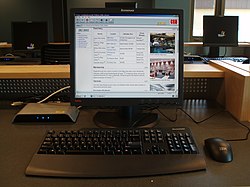INTRODUCTION
A thin client (sometimes also called a lean or slim client) is a computer or a computer program which depends heavily on some other computer (its server) to fulfill its traditional computational roles. This stands in contrast to the traditional fat client, a computer designed to take on these roles by itself. The exact roles assumed by the server may vary, from providing data persistence (for example, for diskless nodes) to actual information processing on the client's behalf.
Thin clients occur as components of a broader computer infrastructure, where many clients share their computations with the same server. As such, thin client infrastructures can be viewed as the amortization of some computing service across several user-interfaces. This is desirable in contexts where individual fat clients have much more functionality or power than the infrastructure either requires or uses. This can be contrasted, for example, with grid computing.
The most common type of modern thin client is a low-end computer terminal which concentrates solely on providing a graphical user interface to the end-user. The remaining functionality, in particular the operating system, is provided by the server.


HISTORY
Thin clients have their roots in multi-user systems, traditionally mainframes accessed by some sort of terminal computer. As computer graphics matured, these terminals transitioned from providing a command-line interface to a full graphical user interface, as is common on modern thin clients. The prototypical multiuser environment along these lines was Unix, and fully graphical X terminals, i.e., devices running X server software, preceded and continued to be relatively popular even after the arrival of thin clients in the mid-late 1990s. Modern Unix derivatives like BSD and GNU/Linux continue this multi-user, remote display/input session tradition. Typically, X server software is not made available on thin clients, although no technical reason for this exclusion would prevent it.
Windows NT became capable of multi-user operations primarily through the efforts of Citrix Systems, which repackaged NT 3.5.1 as the multi-user operating system WinFrame. Microsoft licensed this technology back from Citrix and implemented it into Windows NT 4.0 Terminal Server Edition, under a project codenamed "Hydra." Windows NT then became the basis of Windows 2000 and Windows XP. Today, Windows allows graphical terminals via its Remote Desktop Services component.
The term thin client was coined in 1993 by Tim Negris, VP of Server Marketing at Oracle Corp., while working with company founder Larry Ellison on the launch of Oracle 7. At the time, Oracle wished to differentiate their server-oriented software from Microsoft's desktop-oriented products. Negris's buzzword was then popularized by its frequent use in Ellison's speeches and interviews about Oracle products.
The term stuck for several reasons. The earlier term "graphical terminal" was chosen to contrast such terminals with text-based terminals, and thus puts the emphasis on graphics. The term was also not well-established among IT professionals, most of whom had been working on fat-client systems. It also conveys better the fundamental hardware difference: thin clients can be designed with much more modest hardware, because they perform much more modest operations.

More details on thin client
No comments:
Post a Comment